Now is the time to bring our conversation about whiteness and world-viewing into the present tense. The language and concept of worldviews are somewhat clear in many corners of evangelicalism today, but how does whiteness figure into these concepts? And to what degree could this possibly be a problem among the everyday faithful?
We may well acknowledge some of the historical problems (like Kuyper’s arguments around race and colony) without really thinking that the very form for thought established in those days could itself be a problem. Looking ahead, I acknowledge this is tough work, hard to do well in a short space, and requires good-faith effort from both writer and readers.
In that spirit, for those who have followed this series since the first installment, I want to reaffirm my prior provisos and commitments. This work is about understanding how America’s churches arrived in their current predicament, studded within America’s social divisions rather than offering a compelling alternative. And ultimately, I continue in hope that genuine faith in the living God can reorient our lives, as will come into view in the next few installments.
Below I will introduce the evangelical project since the 1940s when some younger folks set out to restore a biblical worldview (for political engagement, through institutions of higher education and other cultural fixtures) to the silent majority of Americans. And I will observe where the energy for public engagement among visible leaders and movement elites undeniably took on a particular character and color.
“This protest provides an opening to understand how Christian world-viewing can go wrong — in this case, how evangelical witness picks up its silent letters as whiteness.”
Then, I will highlight the witness of one early Black evangelical leader who protested the public witness of mainstream evangelical leaders. This protest provides an opening to understand how Christian world-viewing can go wrong — in this case, how evangelical witness picks up its silent letters as whiteness. Before we break, I will spell out some defining features of “whiteness” relative to world-viewing.
One worldview to bring all the fundamentalists together
The worldview concept took shape within 1940s evangelicalism as part of a conscious attempt to end the cultural isolation and infighting that had characterized Christian fundamentalism for decades.
Fundamentalists had been searching for new ways to speak of faith in a society that was increasingly marked by “Modernism.” Framed in terms of materialism, rationalism and scientific naturalism, Modernism (capitalized to present as a competing worldview) seemed to threaten traditional religious values. The fundamentalist struggle against such threats sometimes spilled into public view, as in the Scopes Trial that took place in Tennessee in 1925.
Exacerbated by a sense of alienation from the wider culture, Christian fundamentalism was marked by divisive infighting about theological and moral minutiae. The rhetoric ran hot, and friendly fire abounded.
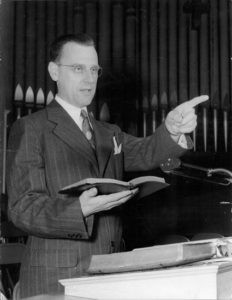
Harold Ockenga preaching
But seeing threats like fascism and Communism abroad and interpreting them as the fruition of godless worldviews, some younger fundamentalists hoped to stop their ilk from eating each other alive while the world burned down around them. Early spokesman and pastor-theologian Harold John Ockenga imagined “a progressive Fundamentalism with a social message.”
While recognizing the need to continue working out the theological details, the younger group seemed to believe the particulars of a worldview framing social life together would be easier to agree upon — even commonsensical among the “unvoiced multitudes” (Ockenga’s words in 1942) of evangelicals. They spoke of the guileless, organic unity of “biblical Christians” and aimed to promote a common sense of public responsibility under the standard of a “new evangelical” worldview.
As historian Molly Worthen puts it, “The rise of Nazism prodded some Westerners to realize that the conflict required not only manpower and matériel but a coherent intellectual front as well.” Here is another way we might understand world-viewing as a kind of impulse. The first was an intuition about race and virtue; the second is a somewhat reflexive, involuntary response to ideological threats.
Casting the new evangelicals
Dreaming of the possibilities for a National Association of Evangelicals, Ockenga called those who maintained their deep roots in orthodoxy to branch out and meet society’s greatest needs. Overall, the strategy would depend on concerted leadership from “the brain trust of the evangelicals” dispersed in various organelles throughout society — media outlets, an organization for colleges and universities, the schools themselves, a clearinghouse for missionary work, organized political lobbies, and more. This placement could facilitate the development and broad dissemination of their worldview over the long haul.
However much the emerging plan was about getting active, Ockenga located the hope of genuine social change in individuals prepared to do “the rethinking and the restating of the fundamental thesis and principles of a Western Culture. There must be today men who have the time and the energy and the inclination and the ability and the support to be able to redefine Christian thinking and to fling it forth into the faces of these unbelievers everywhere.” Ockenga served as the founding president of not only the NAE but also Fuller Theological Seminary.
As early new evangelical leaders eagerly planned a revival of “the evangelical worldview” — a notion often styled more simplistically and more presumptuously as “the biblical worldview” — they left unnamed a number of other salient details they shared in common.
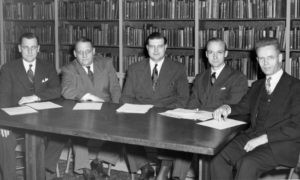
Fuller Seminary’s founding faculty: Harold John Ockenga, Wilbur M. Smith, Carl F.H. Henry, Harold Lindsell, Everett Harrison.
The genuine like-mindedness of many leaders of this movement and more than a few enthusiastic early supporters extended invisibly (to them) beyond any official theological statements into other commonalities like race and political ideology in a still-segregated United States, but also gender and sexuality among others. They were evangelicals indisputably, but they were also straight, white, affluent, male Protestants (to suggest a 21st-century spin on the old WASP acronym) with an affinity for a particular wing of the Republic party.
So, this relatively small number of folks did share a history and a set of convictions sufficient to envision and work toward common goals. Yet as they drummed up support and stepped into the limelight, they named only their cherished religious identity as the essential difference between them and the various threats they perceived. \
Doing the white thing
For those following this series, it should be relatively easy to see how this appeal to the Bible as the source and framework for their worldview turned out to be primarily a rhetorical figment. The new evangelicals clearly supplied extrabiblical ideas to fill out their worldview — not unlike Kuyper weaving his racial hierarchy and support of colonialism into the biblical narrative.
To start rather simply, Ockenga cast a classic Christian nationalist vision, revising America’s golden age as driven by evangelical influence. Filling out the principles of a biblical worldview, he described Christianity as one bank of the river Capitalism, with democracy as the other bank. Assessing the threats to American society, Ockenga worried about the erosion of Christianity on the one side and the frenetic overcompensation of the government on the other.
With an eye toward the question of race in this history, we also might note the tendency of folks in the new evangelical circle to favor voluntary segregation and otherwise slowing down social efforts moving toward integration (not least the possibility of intermarriage). Ockenga himself, at the 1957 NAE gathering, proclaimed, “There is nothing biblically, nothing morally, nothing legally against (integration), but it is not wise, that is all, for expediency’s sake because it is selfish.”
“There is nothing biblically, nothing morally, nothing legally against (integration), but it is not wise, that is all, for expediency’s sake because it is selfish.”
Many comments like this — and public arguments around activism and policy toward the goals of socially conservative whites — could extend this point further. (See my book for more receipts.) Then as now, white evangelicals tended to offer personal-spiritual solutions to racism and to deny the very possibility of structural or institutional problems.
Rather than moving through too many specific examples here, I want primarily to call attention to what little wonder we should have at the lack of ongoing conversation between the new evangelicals and Black evangelicals. The power dynamics generated by the former’s unvoiced identities along with the more overtly exclusive aspects of their movement meant racially diverse others kept their distance from the emerging evangelical establishment. This has continued to be true even among those who would subscribe to the NAE statement of faith or otherwise connect with the primitive lexis of the evangel.
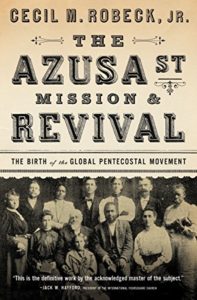 The new evangelicals did not have to be the whites-only enterprise they started out to be. For example, a more radically inclusive spirit was on display in that stream of charismatic evangelicals who appeared on Los Angeles’ Bonnie Brae Street (and later Azusa Street) in the early 1900s. For another example, the Southern Baptist Theological Seminary admitted its first Black students in 1940 (before Fuller’s founding) and ended segregation at the seminary in 1951 (before the Supreme Court’s Brown v. Board of Education of Topeka decision).
The new evangelicals did not have to be the whites-only enterprise they started out to be. For example, a more radically inclusive spirit was on display in that stream of charismatic evangelicals who appeared on Los Angeles’ Bonnie Brae Street (and later Azusa Street) in the early 1900s. For another example, the Southern Baptist Theological Seminary admitted its first Black students in 1940 (before Fuller’s founding) and ended segregation at the seminary in 1951 (before the Supreme Court’s Brown v. Board of Education of Topeka decision).
But the folks out front were organizing world-viewers against threats felt along very specific lines. And, for purely historical reasons that became ensconced in biblical references, their anxieties about the direction of American culture simply did not include movement toward racial reconciliation or much by way of advocacy for civil rights.
To look at one specific instance, as protests grew during the long filibuster of the 1964 Civil Rights Act, Ockenga chided Northern whites involved in demonstrations in St. Augustine, Fla., as “doing more harm than good.” He argued: “The whole situation is rapidly deteriorating. If we break the law by forcing the situation, we are going to encourage the extremist groups. We ought to be careful what we do.”
Remembering evangelical diversity
Evangelicals, as identified in terms of key beliefs and practices or historical connections with earlier Pietistic movements, always have been more diverse than the white, mostly northern elites who led the new charge starting in the 1940s.
Making this statement about “evangelical elites” in 2021 is somewhat humorous. Recent concerns around this subject have tended to underscore the disconnect between visible, relatively progressive scholars and rank-and-file evangelicals. At issue is the ongoing fallout around the supermajority of white evangelicals who voted for Donald Trump. Twice.
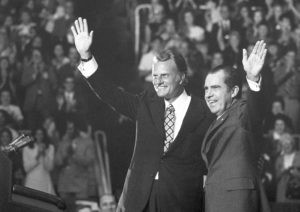
Evangelist Billy Graham and President Nixon wave to a crowd of 12,500 at ceremonies honoring Graham at Charlotte, N.C., on Friday, Oct. 16, 1971. (AP Photo)
At this point in my argument, however, I am talking about the younger evangelicals who raised their voices in the days Richard Nixon was running for president. In those days, elites like Ockenga were stumping for Nixon. To the younger folks playing for the other team in 1972, Ockenga wrote, “I for one cannot understand how any of you men of evangelical conviction can back Mr. McGovern.” And more often than not since those days, white evangelicals issuing their political judgments as the fruits of the biblical worldview have favored the GOP.
Ockenga’s strategy here suggests one way the scope of “the biblical worldview” creeps outward even as it plays a regulative role. Gesturing toward the most basic set of shared convictions is useful to the visible and influential as they define and limit membership in the orthodox party. Underlying their use of the concept is the assumption that, if you start with the same biblical principles, and if you operate in good faith as a born-again believer, you should come to the same political conclusions. And if you do not, you will be defined out of the picture before you ever make it to the convening table.
Not coincidentally, Black American evangelicals are typically not self-identifying as such but rather identified by their adherence to, admittedly problematic, sets of beliefs and practices. And this demographic has tended to fill out their worldview and engage in politics under different assumptions about how the vision should cash out in public.
Historian Mark Noll has noted, “The very high level of evangelical support for Donald Trump is like nothing seen in America’s recent religious-political history — except for the even higher percentage that since the 1960s Democrats have received from Bible-believing, born-again African Americans.”
The curious case of Bill Pannell
Considered “the father of Black evangelicalism,” Bill Pannell found his footing in a space that others (both Black and white) struggled even to see. Describing the mostly white audiences from his days as an itinerant evangelist, he has said, “Some were reluctant to take me seriously because I was a Black person, but they felt obliged because I sounded just like them, believed as they did, was evangelical as they were.” Meanwhile, Pannell found members of major Black church denominations to be “uncomfortable with the term ‘evangelical’ because they see it as a denotation of white culture.”
Throughout his early writings, Pannell described how he began to discover within his own patterns of thought signs that he had been raised to think whitely — not least in his training at mostly white Fort Wayne Bible College. He said of himself and of other Black evangelicals he knew, “From a cultural and theological perspective we were white men.” The essentially white evangelical ghetto in which he lived and moved from his growing up years through Bible school fostered a particular identity politics that the community’s self-understanding could not even begin to articulate.
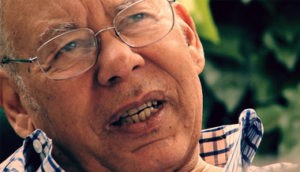
Bill Pannell
Pannell awakened to the power dynamics affecting evangelicalism after the 1963 bombing of 16th Street Baptist Church in Birmingham that killed four young Black girls. He confessed that he was initially critical of the Civil Rights Movement but came to see the disparity between the “good news” preached by predominantly white revivalists and the social scene that they were inept at addressing. In those days, Pannell’s view of Jesus and his work on the Cross was radicalized (vis-à-vis other evangelicals) as he began to see its parallels in the experience of Black persons in America.
Importantly, Pannell identified the racial overlays on the American values of “democracy” and “free enterprise.” As for democracy, he said, “The problem is that one’s internal commitment to democracy has little to do with one’s treatment in this democracy. When you are judged by your color before you can open your mouth, the republic has become a pigmentocracy.”
Speaking of the “freedom” advocated by American patriots, he named its “limited or parochial” application in the United States. Pannell boldly charged, “The mentality that produced and prospered the system of slavery is still with us. Today, we don’t own slaves, we rent them, and for the non-white this system of enterprise is anything but free.”
As he weighed the feedback he received from his conservative white evangelical frenemies, Pannell called out the tendency toward a certain set of politics. He mused, “My white brother … taught me to sing ‘Take the World but Give Me Jesus.’ I took Jesus. He took the world and then voted right wing to ensure his property rights.”
Pannell learned to see that too many evangelicals were “perpetuating the myth of white supremacy” and “associating Christianity with American patriotism (it’s called nationalism when we criticize its manifestation in Africa), free enterprise, and the Republican party.”
Given his training, Pannell could speak as an insider to white American evangelicalism. Pannell’s message was primarily the gospel itself. But he came also to the conclusion that he needed to confront socially conservative white evangelicals. The gospel that claimed all their lives equally did not, as the basis of an all-encompassing worldview, lead to the policies the white folks were advocating.
“While they claimed to represent all biblical Christians, white evangelical elites simply could not do that in good faith.”
While they claimed to represent all biblical Christians, white evangelical elites simply could not do that in good faith. After all, they were not really in conversation with a diversity of biblical Christians. And this put them at risk for baptizing commitments that came to them in other ways and, in effect, honkifying the gospel.
Learning from Critical Race Theory
At this point, I can start speaking more directly to what “whiteness” is and how it gets bound up in the fabric of churches and parachurch organizations like schools and associations. And we can unpack Pannell’s comment about learning to think whitely in his Bible college education — and maybe answer his plea for “the courage and humility to confront fellow believers honestly about attitudes that divide them.”
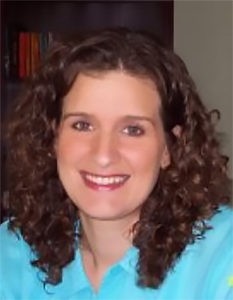
Wendy Leo Moore
Here some actual Critical Race Theory might help us. Learning from the work of folks like Wendy Leo Moore, we might see the parallels between (a) how race comes to determine outcomes within the legal system and to suffuse the culture of law schools and (b) how whiteness lingers within the institutional cultures of churches and parachurch organizations, especially those that began as whites-only institutions.
Speaking in the context of American law, Moore describes how, once the norms and practices were generated in the absence of diverse actors, the experts could assert the law is “a neutral and impartial body of doctrine unconnected to power relations.” I, for one, sense a strong resonance between this description and Ockenga’s gesture toward “the authority of the Bible alone uninterpreted by traditions” as a virtue of evangelical faith.
But if you want to know why whiteness is in the air for so many institutions, Moore argues, “attention must also be paid to the historical racial exclusion that … provided the context for the uncontested construction of white institutional space.” Advantages are structured into institutions by way of founding representation and are invisible from the start because of the regulating influence of founders and early adopters. They set in motion a social machine that will invariably strive to maintain homeostasis, to conserve itself amid the push and pull of latecomers.
And while structures may formally open to, or even invite, a diversity of faces, the prevailing norms and practices came into being without the input of diverse voices. Under these conditions, institutions tend to attract and, in some ways, to select for new folks who look different but think the same. This phenomenon is known as “managed diversity.”
The formal reality that churches are voluntary associations serves to mask these dynamics within any given institution, not least many churches intentionally branding themselves as multiracial or multiethnic in culture. (More on this later in the series.)
It is axiomatic that institutions struggle to change and prefer to conserve energy — if possible, appearing to change more so than really changing. Certainly, there is more integration now than before, even less intentional racism, and often a move toward colorblindness (which carries its own trouble, but that is a conversation for another day). However, these kinds of moves tend not to be accompanied by deep analysis or change around the guiding norms or basic principles that continue to sit underneath the institutions.
This axiom is true even on the evolving, progressive side, where we can see the lingering effects of white institutional space. In 2018, students at Fuller Theological Seminary interrupted graduation events to protest the curriculum’s pervasive white cultural frame. (This at a school with centers dedicated to Black church studies and Asian American theology and ministry as well as a Centro Latino!) We must learn to wrestle more honestly with the many realities (daresay, traditions) within which we learn to interpret the Bible.
Whiteness and world-viewing
From the outset, what I mean by whiteness is not exactly about ethnicity or specifically about skin color, although that has been a clear marker over the last 400 or so years. As we shift toward naming something like a way of seeing the world, we call it “whiteness” because some of its most obvious features coemerged in the colonial moment with modern racial hierarchies. And we have the testimony of Black voices throughout this history (like W.E.B. Du Bois, but also Bill Pannell) naming the reality and their exclusion from it.
As I say in my book, whiteness might be understood through a culinary metaphor as a kind of blandness, a basicness that is home to the dopamine-releasing fats and sugars our bodies crave. More literally, whiteness is the unquestioned aptitude to participate in the norming group in any given room, the privilege of not questioning whether one really can or ought to try ordering, grasping, or even viewing the whole world.
Whiteness is the easy, unquestioned, often invisible extension of one’s own ideas into the world as the norm in a world where some folks are routinely unseen, oppressed and otherwise left out of the conversations that generate public definitions (including what it means to be “evangelical”).
“Whiteness tends to manifest as just feeling right, feeling like a well-meaning person.”
Without adequate reflection on our many identities, social power is routinely transfigured into theopolitical power. Put bluntly, persons and groups that already enjoy social power (for example, heterosexual white American evangelical men) effortlessly become authorities on Jesus’ identity, God’s will and so on. As such, whiteness tends to manifest as just feeling right, feeling like a well-meaning person (for example, good intentions even if a sinner), and so on.
Worldview conceptuality did, in fact, take root in the elite evangelical circles, but it clearly has taken on a life of its own and a mass appeal. And this observation makes the everyday use of the concept and the common impulse to engage in this style of thinking fair subjects for analysis.
Not everyone enjoys the special powers that come with being a part of the elite group of world-changers who might first come to mind. But as a spiritual posture, whiteness can be performed by anyone who has a social media profile, who argues at a table with their family members, who casts a vote in this or that election. And, quite clearly, this also means that thinking whitely in the way I am criticizing is not limited to folks who could be identified racially as white.
Anyone can gesture toward “the biblical worldview” in place of a detailed argument for their judgment on an issue. And if the folks who have done the most work to develop this theory have clear blind spots, others who deploy it are bound to exhibit some sort of family resemblance.
Learning to speak the unspoken reality
What I am concerned about under the heading of “whiteness” is not limited to evangelicals or even to the specific language of “the biblical worldview.” The problems can be manifest in the way Southern Baptists (among others) throw around the adjective “gospel” to describe their perspective on some issue. For others, “kingdom (of God)” or even the narrative language of “the Great Story” can tend the same direction.
In any case, within the fold (whichever fold), these underspecified concepts are invested with lots of energy and become serviceable to address the current anxieties of whoever has the mic. The folks on stage can gesture toward these relatively empty signifiers to justify their positions and consolidate support without having to make much of an argument for the folks who already agree.
“The continuous, silent creeping of the biblical worldview to cover and encompass more terrain in the world is part of its trouble.”
The continuous, silent creeping of the biblical worldview to cover and encompass more terrain in the world is part of its trouble. Particularly because it is so often unnamed, this activity of the mind covers more conviction sets and loyalty bases than most folks care to admit let alone announce. What was clear to Pannell but invisible to many mainstream white leaders was this: the growing number of neo-evangelical organelles maintained and articulated a “worldview” that was both more and less than “biblical.”
If we can, even for a moment, honestly assess ourselves, or maybe it is safer to start with powerful expositors like the case studies in my book, then we must see how the form of a world-view — its all-seeing, all-ordering tendency — drives human beings to narrate whatever they think they know, however grizzly it may be, as the stuff of divine revelation. And in so doing, one can enjoy the support of likeminded others and claim the moral high ground without making much of an argument and swatting away Christological scrutiny.
At the same time, the world-viewing impulse drives us to see ourselves through the ideals of the worldview, which have tended to romanticize our minds in terms of unified, rational thought structures. Many of us have been trained to think of ourselves as singular individuals who freely associate with others as we please and engage the world through such frameworks — or create problems as we allow the emotions to leach into our thinking. To this shortcoming of worldview theory as well as some hopeful alternative ideas for understanding ourselves, we will turn next.
This is the third in a series of articles introducing the hypothesis of the author’s new book, Worldview Theory, Whiteness, and the Future of Evangelical Faith.
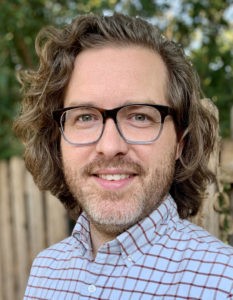
Jacob Alan Cook
Jacob Alan Cook is a postdoctoral fellow at Wake Forest University School of Divinity. He is the author of Worldview Theory, Whiteness, and the Future of Evangelical Faith as well as chapters on Christian identity, peacemaking and ecological theology. He earned a Ph.D. from Fuller Theological Seminary.
Related articles in this series:
What if your ‘Christian worldview’ is based upon some sinful ideas?
A short history of the roots of colonialism, racism and whiteness in ‘Christian worldview’


